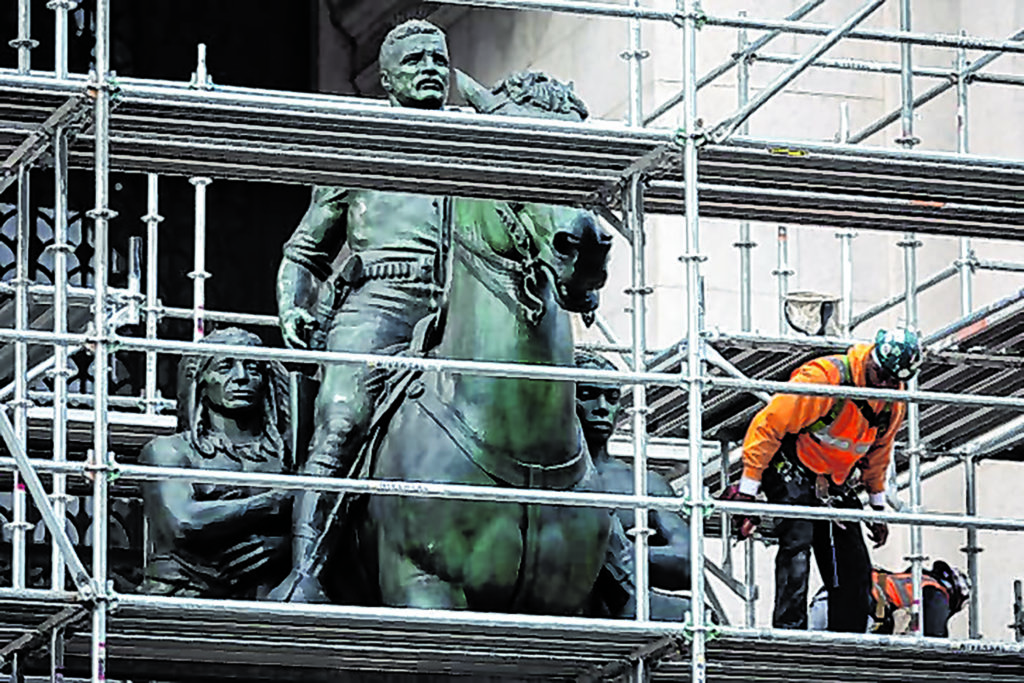
First Thomas Jefferson. And now, Theodore Roosevelt.
Next door, in New York City, the war against American history—and the American nation—continues.
In the summer of 2020, on the heels of nationwide rioting that followed the death of George Floyd, the statue, which sat at the entrance to the Museum of Natural History on 200 Central Park South was ordered to be removed by The New York City Public Design Commission. The move was supported by then-New York City Mayor Bill de Blasio. The removal cost the taxpayers $2 million.
Recently, the act was committed and the statue taken down in the dead of night.
The iconic statue, which for the past 80 years has greeted visitors to the museum has been shipped off to the Theodore Roosevelt Presidential Library in Medora, North Dakota. Medora has all of 112 people, 94 percent of whom are white.
A museum spokeswoman said the removal is part of an overall restoration plan. The statement also found some kind words to say about the once-beloved Roosevelt.
“The process, conducted with historic preservation specialists and approved by multiple New York City agencies, will include restoration of the plaza in front of the Museum, which will continue through the spring,” a museum spokeswoman said in a released statement. “The museum is proud to continue as the site of New York State’s official memorial to Theodore Roosevelt.
This follows an earlier decision by city officials to remove a statue of Thomas Jefferson from the New York City Council chambers. That came after members of that chamber’s black, Latino and Asian caucuses came out against the statue. The Jefferson statue was first commissioned in the early 19th century to honor Jefferson’s support for religious freedom in the United States. It was first displayed in City Hall in 1834 before moving to the main chamber in 1915. The statue was paid for by Navy officer Uriah Phillips Levy, a New Yorker who was one of the first Jewish officers in the service. It’s a plaster version of the bronze statue that stands in the Capitol Rotunda in Washington, D.C., which Levy also gifted to the U.S. government. The New York statue is now under the jurisdiction of that same public design commission.
The Roosevelt statue depicted the man on horseback being guided by an American Indian on one side and black man on the other. The statue’s creator, according to media reports, intended the depiction to celebrate Roosevelt’s “friendliness to all races.” The public design commission thought otherwise. So too did Theodore Roosevelt V, a family descendant. Last summer, he told the media that it was “fitting that the statue is being relocated to a place where its composition can be re-contextualized to facilitate difficult, complex and inclusive discussions.”
Over the past five years, more than 100 historical statues and monuments across the country have been removed, relocated, taken down or melted. Violent incidents in Charleston, Charlottesville and Minneapolis are driving the wheel. The first instance came in 2017, when the New Orleans City Council voted to remove four Civil War statues in that city: Those of Robert E. Lee, Jefferson Davis, Pierre Beauregard and one commemorating a fire fight between a white militia and a black militia that took place during the Reconstruction era. After the violence in Charleston in 2015, the City Council in Charlottesville, Va. voted to remove statues of Lee and Stonewall Jackson. That was met with a 2017 “Unite The Right” rally protesting those removals, one that resulted in more violence, the death of a female leftist activist at the hands of a young man from Ohio. That led to more Lee and Jackson statues being removed, plus a bust of Christopher Columbus in Yonkers and one of Abraham Lincoln in Chicago both being fire-bombed. After Minneapolis, the violence escalated. The Confederate statues of Lee and Jackson in Richmond, VA, were removed. Monuments to Ulysses S. Grant in San Francisco, Thomas Jefferson in Portland and Columbus in Minneapolis were torn down. A statue of George Washington in New York’s Washington Square Park was vandalized.
Roosevelt is, of course, Nassau County’s most illustrious historical figure. Born in New York City, Roosevelt died at his Sagamore Hill home in Oyster Bay. The 25th president of the United States, Roosevelt also served as a New York City police commissioner, the governor of New York, Assistant Secretary of the U.S. Navy and Vice President before entering the Oval Office after the assassination of President William McKinley in 1901. At the time, Roosevelt was the youngest president in U.S. history. In 1904, Roosevelt was re-elected president. Two years later, he won the Nobel Peace Prize for his role in ending the 1905 Russo-Japanese War. In 1912, he ran as a third party Bull Moose candidate for president. He finished third to Woodrow Wilson and President William Howard Taft. During that campaign, Roosevelt, while giving a speech in Milwaukee, was shot in the chest by a would-be assassin. Undaunted, a blood-soaked Roosevelt continued speaking for the next 90 minutes.
As Assistant Secretary of the Navy, Roosevelt rallied for a war against Spain in the Caribbean and in the Philippines. When war commenced, Roosevelt resigned his post and formed his own unit, The Rough Riders, to fight the Spaniards in Cuba. Roosevelt’s youngest son, Quentin, died in combat during World War I, a tragedy that might have contributed to his father’s premature death in 1919 at age 61. Over 20 years later, Roosevelt’s oldest son, Theodore Roosevelt II, took part in the June 6, 1944 D-Day landing, directing troops at the Utah Beach landing, for which he received a Medal of Honor. The latter was 57 at the time. Jefferson, for his part, served in the Virginia militia.
A New York City tabloid called the removal Roosevelt’s “rough ride” in reference to that same Rough Riders unit. It is more than a rough ride. It is an assault on both American history and the American nation itself.


































